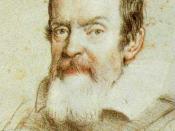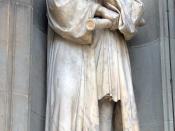Galileo Galilei is supposedly to have investigated the laws of motion by dropping cannon balls from the top of the Leaning Tower of Pisa. In 1604 he deducted that, without friction, all falling objects (light or heavy) would fall at the same acceleration. However, Galileo's ideas were not entirely accepted by people at the time. Our present-day ideas about forces and motion mainly originate from Isaac Newton's laws of motion, which he concluded around 80 years after Galileo had made his observations.
Planning
Aim
I am going to carry out an investigation to question Galileo's falling bodies theory, and to see whether he was right with his observations.
Equipment
* Ticker timer (and tape)
* A selection of weights (100, 200, 300, 400, 500, 600, 700, 800, 900, 1000g)
* Stop clock
* 2V power supply
* Metre-rule
* G-clamp
* Connecting wires
* Carpet square to protect the floor
I carried out a preliminary experiment to test whether two different weights fall with the same speed.
I used stop clocks because I thought that they would provide adequate readings, but I did a repeat experiment so that I could find averages from the two sets of results. Carrying out a preliminary experiment gave me an indication of which sets of weights would work best for my investigation. Looking at the results of my preliminary experiment, I can see that Galileo's theory did slightly apply because the time it took the weights to fall to the ground was roughly the same for each weight.
Using the results from my preliminary experiment, I can make a prediction that for every weight that I use, it will have a similar speed when dropped from a metre high. I think this because I used 0.5 kg, 1kg and 2kg weights in the...


